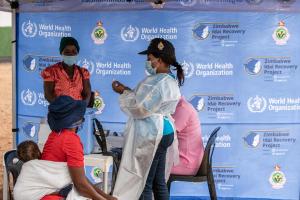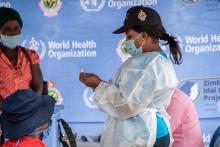More than 45 000 people benefit from free health care services in Chipinge and Chimanimani
Chimanimani, Zimbabwe - Over the past two years more than 45 000 people in the Cyclone Idai affected communities have benefited from free integrated health and Gender Based Violence (GBV) services provided by WHO, UNICEF, UNOPS-CI and UNFPA under the Zimbabwe Cyclone Idai Recovery Project (ZIRP). UNICEF and WHO trained village health workers (VHWs) on essential health information, basic maternal, newborn and child health services. The VHW have been instrumental in mobilizing communities to come and access the services provided by UNFPA and WHO at the same time during the community outreach. UNFPA has been providing GBV services in partnership with Musasa Project and FACT, while WHO has been providing free health services at static and outreach points . Moreover, UNOPS-CI has supported the procurement of vehicles, medical equipment and sundries, and the rehabilitation of health centers.
Under the ZIRP, which is being funded by the World Bank to restore livelihoods and communities affected by Cyclone Idai in 2019, the lives of thousands of survivors have changed for the better. The project, managed by UNOPS, is being implemented by several other United Nations partners including the Food and Agriculture Organization, UNICEF, UNFPA and World Food Programme among others. ZIRP has helped to bring health care and other services closer to the people and thousands have benefited from it.
According to Dr Tapiwa Nyamangodo, the Clinical supervisor for the project, cyclone affected communities are still suffering and in need of medical care. But because most of these people cannot afford to travel long distances to the clinics or even to pay for the services, the free assistance from the ZIRP has made a difference.
More than two years after the devastating Cyclone Idai hit Chimanimani, communities are still trying to pick up the pieces of their lives. For Takemore Mufuya, that journey has not been easy. After losing her husband and child in the disaster, she struggled to take control of life again.
Like many other survivors of Cyclone Idai, Takemore struggled with ill health until she was diagnosed with high blood pressure at one of the WHO mobile outreach clinics under the ZIRP.
“Once I started taking my medication, I became a different person. I can now work to put food on the table for my children and I have received counselling which has helped me to finally accept my loss and start healing emotionally,” Takemore said.
World bank country manager for Zimbabwe Marjorie Mpundu commended the implementation of the programme which she said had been instrumental in bringing health services closer to the people.
"One of the things we tried to do was help communities restore health services that were available originally before the cyclone. We have done the rehabilitation of basic health services structures like the clinics and l am happy that this programme has integrated the health, the COVID-19 response but more importantly the GBV aspects. This is a good way of offering one stop health and social support to the community and seeing them respond to the calamity that they faced," she said.
Besides the clinical services, the project has supported Government of Zimbabwe’s COVID-19 response as well as training of health care workers on healthcare management. A total of 130 Environmental Health Technicians (EHTs) and 168 health workers were trained on IPC disease surveillance and case management.
“We have also supported the surveillance pillar where we have capacitated environmental health technician response teams with technical and logistical support they need to respond to COVID-19. Together with UNOPS-CI, we also procured motor bikes which they use to respond to COVID-19 alerts,” explains Dr Siwela, WHO ZIRP project coordinator.
In addition, the GBV response of the project has been a major drawcard as women can access services as they get their baby growth monitoring and family planning services. UNFPA technical specialist for GBV Ms Verena Bruno said this had been successful through the use of the mobile one stop centre for GBV survivors.
Although, WHO integrated health services ended in December 2021. The provision of the comprehensive and integrated health services through mobile health service presented a good promise for sustainability beyond project cycle as WHO incorporated the Ministry of Health and Child Care (MoHCC) staff in every outreach session. Working with WHO ZIRP staff, MoHCC nurses gained experience on how integrated mobile outreaches operate. The nurses also benefited from project trainings which include comprehensive management of emergency obstetric and neonatal complications and clinical management of rape survivors.




